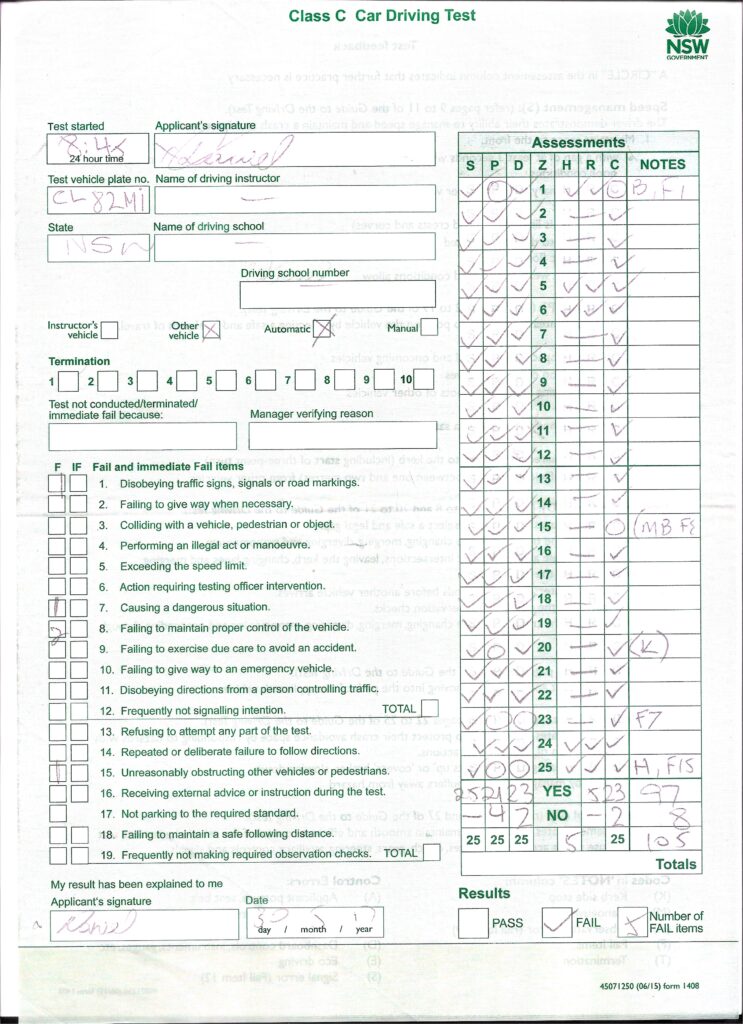Passing the practical driving test in New South Wales (NSW) can seem challenging, especially for those who have never taken the exam before or learned to drive in another country and picked up bad habits behind the wheel. Knowing the structure of the test, the assessment criteria, and the serious errors that lead to failure is essential to increase your chances of success.
If you already have a license in Brazil, I recommend that you forget how the test works there, because here it’s completely different. In NSW you are responsible for providing the car, whether it’s your own, rented, or borrowed.
Make sure the car is suitable for the test. Before starting, the examiner will check the indicators, brake lights, tires, windows, and mirrors. If the car isn’t roadworthy, the test will be terminated before you even start the engine, and you’ll need to reschedule. That’s why you should avoid renting or borrowing a car without checking everything first (on page 36 of the Guide to the driving test, you’ll find the full car requirements)
Understanding the test

The test in NSW lasts about 35 minutes and is divided into 25 Zones (the route is broken into 25 sections). In these zones, applicants are assessed on four fixed criteria and one variable:
- Speed Management (fixed)
- Road Positioning (fixed)
- Decision Making (fixed)
- Vehicle Control (fixed)
- Hazard Response (variable)
The four fixed criteria are assessed throughout the test and add up to 100 points (25 each). The variable score depends on the number of hazards that occur during your drive. For this reason, the total test score can vary. I’ve seen tests with just 2 hazards (total 102 points) and others with 15+ hazards.
To pass, you must achieve at least 90% of the total points without committing ANY SERIOUS ERRORS! Most people who fail actually reach the minimum score, but end up making critical mistakes that cost them the test.
For example, when I did my first test in 2017, I reached 92% but failed because I committed 5 serious errors. I’ve also seen students score 99% but fail because of a single mistake during the entire test.

This was my own test sheet. Notice that even though I reached the minimum passing score on the right-hand side, I still failed because of 5 serious errors recorded on the left. In other words, it doesn’t matter how well you perform if you don’t come to a complete stop at a STOP sign, for example.
To pass the test, you need to understand both the scoring criteria and the fail items (F1–F19), which you absolutely cannot commit. You’ll find a description of each of them on page 31 of the Practical Test Guide. If you’re my student, you’ll also receive an exclusive ebook where I explain these errors in detail and include illustrations showing the most common ones (and of course, I also cover them in class).
I’ve seen many people who aren’t great drivers still pass this test, simply because they understand this concept (similar to the PTE – you don’t need to speak English well to pass). The test itself is simple, but it’s full of details, and you need to pay close attention to succeed.
That’s why I always recommend students to schedule a lesson well before the test day rather than booking it for the day before. That way, you’ll have time to practice and internalize the rules that will help you pass.
📌 Book your lesson and count on my help to succeed in this process!
